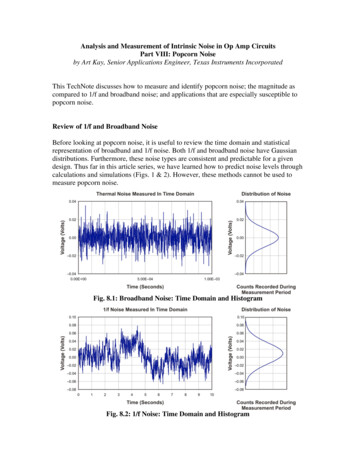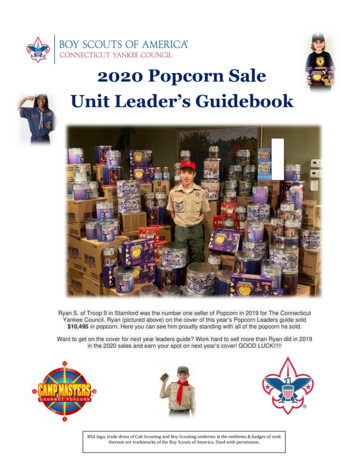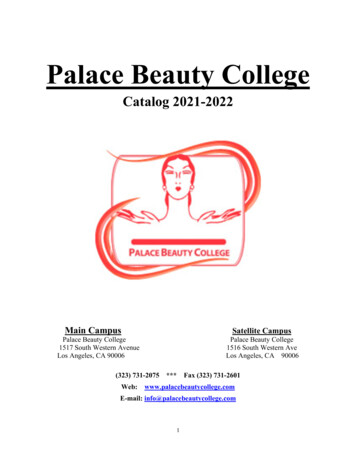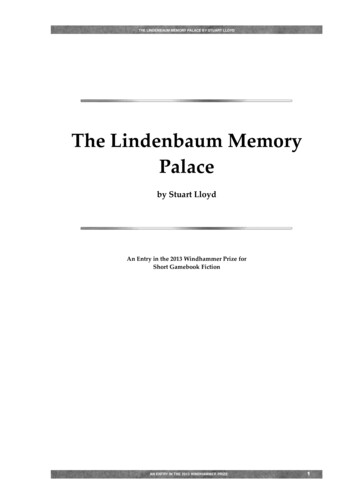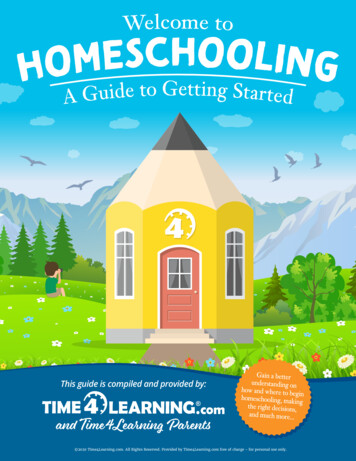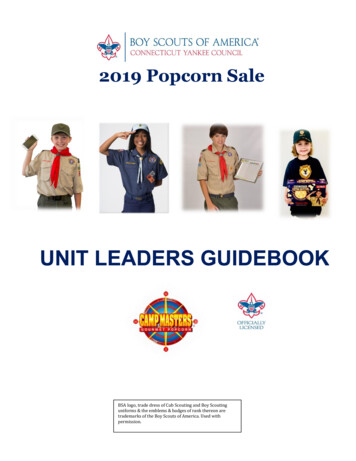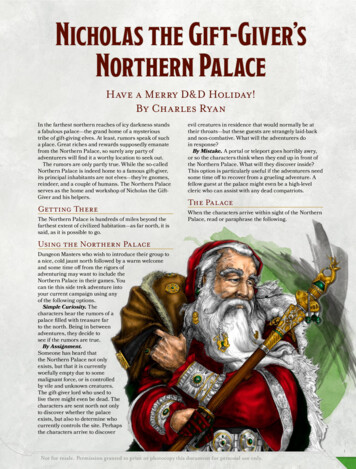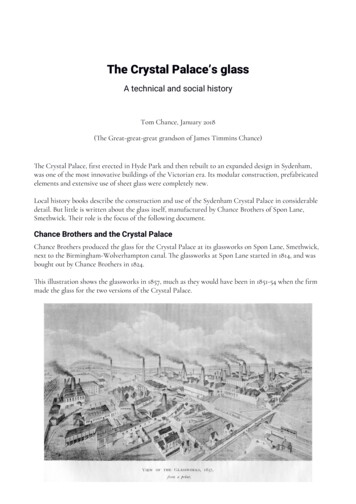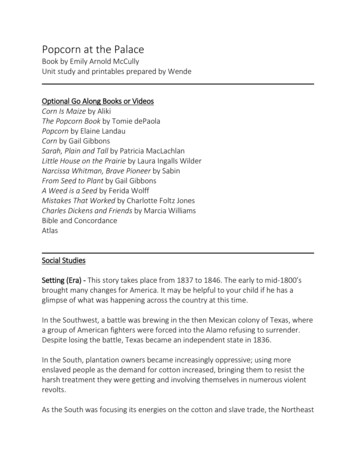
Transcription
Popcorn at the PalaceBook by Emily Arnold McCullyUnit study and printables prepared by WendeOptional Go Along Books or VideosCorn Is Maize by AlikiThe Popcorn Book by Tomie dePaolaPopcorn by Elaine LandauCorn by Gail GibbonsSarah, Plain and Tall by Patricia MacLachlanLittle House on the Prairie by Laura Ingalls WilderNarcissa Whitman, Brave Pioneer by SabinFrom Seed to Plant by Gail GibbonsA Weed is a Seed by Ferida WolffMistakes That Worked by Charlotte Foltz JonesCharles Dickens and Friends by Marcia WilliamsBible and ConcordanceAtlasSocial StudiesSetting (Era) - This story takes place from 1837 to 1846. The early to mid-1800’sbrought many changes for America. It may be helpful to your child if he has aglimpse of what was happening across the country at this time.In the Southwest, a battle was brewing in the then Mexican colony of Texas, wherea group of American fighters were forced into the Alamo refusing to surrender.Despite losing the battle, Texas became an independent state in 1836.In the South, plantation owners became increasingly oppressive; using moreenslaved people as the demand for cotton increased, bringing them to resist theharsh treatment they were getting and involving themselves in numerous violentrevolts.As the South was focusing its energies on the cotton and slave trade, the Northeast
was pouring its resources into the first factories in the United States. There wasalso an influx of immigrants from Europe to the New England area from 18201860.And as for Illinois where the Ferris family lived? After the Louisiana Purchase in1803 more and more people began moving farther west, bringing an end to theAmerican Frontier. So that your child can properly place these events in history,make mention that it was after the Revolutionary War and before the Civil War,and place a time line piece on your time line at 1846 if desired. Many rabbit trailscan be taken, to give your child a good glimpse of what the whole country was likeat the time Popcorn at the Palace takes place.Pioneers - Have your child look through the pictures and reflect on the story,describing what it was like to live as a pioneer in the 1830’s-40’s. How did theydress? How did they travel? What kinds of food did they eat? What were theirhomes like? What did children do for fun? Have your child use the pioneernotebook paper to write about pioneers.A pioneer is a person who goes first and opens the way for others to follow. On thefirst page of Popcorn at the Palace we read about a group of pioneers going intothe wild frontier of Illinois in 1837. We see by the picture that they traveled bycovered wagon, in a group called a “wagon train.” Most wagons were pulled byoxen, which were slow but strong. The pioneers carried with them only the basicnecessities including flour, salt, cornmeal, bedding, some tools, and a few pieces offurniture. There were many dangers on the trails, including herds of buffalo, deeprivers, heavy rains, wild animals, and unfriendly Indians. It took a very brave groupof people to face the long trip to the new land.There were many reasons people decided to move to the frontiers. Many werelooking to own their own land, others hoping to find work or food more plentiful.Often, people of the same religious groups would travel together, in search ofreligious freedom and/or separation, and such was the case with the Galesburgerswho were led by Reverend George Washington Gale, a Presbyterian minister. 1837was the year that American Presbyterians split into “old” and “new” schools ofthought. Ask your child which school of thought the group in our story is from?Once the pioneers reached their destination, there were no stores to purchase
supplies from. They would build houses out of logs from trees they cut down,usually only having one or two rooms. Beds were made of deerskin strips or ropesto make the springs, and mattresses filled with straw. Soap, candles, and fabric allneeded to be made, food was hunted or grown by the pioneers and cooked over afire, and books were read by candlelight.Pioneer children had to work hard, with the boys hunting, bringing wood andwater, and the girls spinning, weaving, and churning. Toys were rare, except forhomemade ones such as the cornhusk doll that Maisie made. The children learnedto read from the Bible, which was often the only book available. They also loved toplay games, and dance to the fiddle music played in the evenings.Search your library for more books about early pioneers. It is always aninteresting, enjoyable subject for children to expand upon. Some possibilities are:Sarah, Plain and Tall by Patricia MacLachlanLittle House on the Prairie by Laura Ingalls WilderNarcissa Whitman, Brave Pioneer by SabinIllinois – The Ferris family moved to Illinois. Before pioneers ventured into the vastprairies, wild buffalo and Native Americans occupied them. Prairies are vast areasof flat grassland. The fertile soil and vast prairies of Illinois were very attractive tothe industrious pioneers. Much of the natural lands were then replaced with fieldsof grain and grazing land for livestock. Have your child locate Illinois on a UnitedStates map. Illinois is in the Midwest, among the states called the “corn belt”. It isbordered on the north by Wisconsin, on the east by Indiana, on the south byKentucky, and on the west by Iowa and Missouri. Show your child how the state’snatural boundary line on the west is the Mississippi River. Illinois’ capital isSpringfield and its largest city is Chicago. The state has many nicknames including“Corn State,” “Prairie State,” and “Land of Lincoln.” Illinois joined the Union in1818 as the 21st state, just nineteen years before the Ferris family arrived.Map Skills – Using a United States Highway map, trace out a possible route Maisieand her father took from Illinois to New York. What direction did they need totravel? How many states were crossed? What kinds of landforms wereencountered on the trip (mountains, rivers, etc.)? Approximately how many mileswere traveled? Now look at a world map. What ocean did they have to cross to getfrom New York to England? About how many miles did they travel?
England – Maisie and her father took popcorn to England. Have your child locateEngland on a world map, in the continent of Europe. England is part of the BritishIsles, which also includes Scotland, Ireland, and Wales. London is England’s capital.Have your child examine the double page spread of Buckingham Palace.Buckingham Palace has been the official London home of the British royal familyfor well over 150 years. Palace guards have the important job of protecting theroyal family from unwanted visitors, and are not allowed to speak or smile while onduty. Take notice that there is no flag flying over the palace. The flag is only flyingwhen the Queen is home. Windsor, where Maisie and her father were to meet theQueen, is the site of Windsor Castle, the primary home of the British ruling family.You may also want to discuss with your child the royalty of England, to whateverextent interest/understanding warrants. Victoria became the Queen of England in1837 at the age of 18 when her uncle, William IV died. She married her first cousin,Albert. Queen Victoria was a very influential figure in history, and even had an eranamed after her, the Victorian Era. Research and write about Queen Victoria onthe notebook page provided.Relationships – Popcorn at the Palace illustrates a close relationship between afather and daughter. We are told in the beginning of the story that “Maisie Ferristook after her open-minded father.” Explain to your child how a lot of personality(and physical) traits come from our parents, and discuss how your child may takeafter one of his parents. Maisie and her father also worked together (point outwho is on the horse helping her father thresh), learned together, traveledtogether, and imagined together. Ask your child to recall a special time he spentwith his father (or mother, uncle, grandparent, etc.) maybe taking a trip or justhaving a special daddy/child day.ScienceSeeds – Olmsted Ferris was excited by the beautiful wild prairie flowers, and hegrew mustard, canary grass, and corn. These are all plants that start out as a singleseed. A seed is a little package of plant life. A seed coat protects the inside embryo,which is the baby plant. Explain to your child how not all seeds will grow though.They need air, plenty of water, and the right temperature and amount of light tobegin to grow, or germinate. After the seed germinates, the root grows down into
the soil, and the shoot grows up towards the sun. The leaves, buds, and flowersgrow from this new shoot. The richer and more fertile the soil is (like that ofIllinois), the healthier the plant will be. If possible, show your child a mustard seed(can be found in spice section of grocery store), a canary seed (in bird food), and acorn seed (the kernel that you eat is the seed), as well as some wild flower seeds.Let him plant a seed in some soil, water and watch it. Extend your study of plantsinto how seeds travel, the process of photosynthesis, the foods that come fromseeds, and plant life cycle. Some go along books include:The Magic School Bus Goes to Seed by Joanna ColeThe Magic School Bus Plants Seeds by Patricia RiefFrom Seed to Plant by Gail GibbonsA Weed is a Seed by Ferida WolffInventors and Inventions – Olmsted Ferris was an inventor. He invented a machinefor threshing the seed out of the mustard and canary grass. He was always thinkingand tinkering, trying to come up with the next great invention. Many people didn’tunderstand Olmsted and his adventurous, open-minded attitude. That is, until hewas actually successful. Fill out an Inventor Trading Card for Olmsted Ferris. Manyinventors throughout history were treated the same way. They were ostracized forthinking outside the norm. Discuss with your child how to think like an inventor.Inventors take the time to dream, relax and tinker. They take chances, overcomefailures, and learn from their mistakes. A fun book to read about inventionsis Mistakes That Worked by Charlotte Foltz Jones. Encourage your child to come upwith an invention of his own. To decide what kind of item he would like to invent,have your child ponder these questions: How will it work? Are there any others likeit? Who needs your invention? What is your goal (make people’s lives easier, savelives, advance science, make money, etc.)? What will it be named? How much willyou sell it for? After going through the brainstorming process, let your childconstruct his invention and demonstrate how it works.The people of Galesburg, Illinois did come around to Olmsted’s way of thinking,and started dreaming up their own inventions and enterprises. Your child may beinterested to know that it was the nephew of Olmsted Ferris, George WashingtonGale Ferris, Jr. (1859 – 1896) who invented the Ferris Wheel!Blushing – When Olmsted introduced Maisie to the queen she blushed crimson.Sometimes when we are in a situation that is embarrassing or uncomfortable, we
blush. Ask your child if he can recall a time when he blushed. Blushing causes yourface, ears, and neck to turn red, and sometimes you get a tingle over your body.Young people blush more often than older people. When you blush, your heartrate goes up and you start to breathe faster. The blood vessels that go to your faceopen up (dilate) so more blood than usual flows to your face, changing it to a redcolor. Blushing is a normal, involuntary action that happens to everyone at onetime or another.Corn/Popcorn – Corn is a species of tall cereal grass, which is grown for its seedand used as food for people and animals. The Native Americans were the first tointroduce corn to the early pioneers, but archaeologists have found ears of corn inNew Mexico that were nearly 5,600 years old! There are numerous different kindsof corn but only one kind that pops. Popcorn grows on a cob, just like the sweetcorn you eat in the summer, but popcorn farmers let the corn dry before they takeit from the plant. Americans consume 16.5 billion quarts of popped popcornannually. Only 70% of that is eaten in the home, the rest is consumed at theaters,ballparks, and the like. Popcorn is nutritious too. One cup of popcorn provides 1.3grams of dietary fiber, and also has more protein, phosphorus and iron than mostother snacks.Does your child know what makes popcorn pop? While a kernel of dried corn doesnot seem wet, inside there are tiny drops of water. As the dried corn is heated up,the drops of water turn to steam and expand. The steam bursts out and flies outinto the air, leaving a fluffy white jacket behind. Use the How Popcorn PopsNotebook page for your child to describe how popcorn pops.Other than popcorn, what products do we get from corn? Have your child make alist. Some possibilities are corn oil, cornstarch, corn meal, and ethanol. Foods fromcorn could include corn flour tortillas, corn chips, corn bread or muffins, cornfritters, Corn Pops, etc. Use the corn notebook paper to record your list.Language Arts –Vocabulary – Discuss these vocabulary words with your child as you come uponthem in the story. Child may do the vocabulary word search, if desired.
Devout – religiously devoted. They were a devout and enterprising band ofpioneers.Enterprising – energetic, bold, venturesome. They were a devoutand enterprising band of pioneers.Scriptures – The Bible. They lived according to the Scriptures.Parlor – A room for reception of callers. They had only the Bible in theirnew parlors.Intrigued – Fascinated; Aroused curiosity; Stories about the royalfamily intrigued Maisie.Threshing – Beating stalks of ripened grain to separate the grain from the straw orhusk. He invented a machine for threshing.Standoffish – Coldly reserved. The children were standoffish with Maisie.Faring –Doing; Getting on. They reported on how the pioneers were faring.Civilly – Properly; Politely; They could hardly speak civilly to him.Proportion – Size; It was all out of proportion!Relented – Become more gentle. Olmsted relented.Hence – From this time. Be at the Palace three days hence.Etiquette – Rules for polite behavior. There is an etiquette to be presented at Court.Lady-in-waiting – A lady appointed to attend upon a queen or princess. A lady-inwaiting is here to teach you.Page – A male servant or attendant. A page announced that the Queen wouldreceive them.
Consort – A spouse. The Queen and her Consort.Crimson – A deep red color. Maisie blushed crimson.Footman – A male servant. A pot was provided by the footman.Peculiarly – Particularly; Exclusively; This is peculiarly American.Ahem – An exclamation similar to the sound of clearing a throat. “Ahem,” saidPrince Albert.Beckoned – Signaled or summoned. The Queen beckoned to Maisie.Sensation – That which produces great interest or excitement. It was a sensation.Figures of Speech – A figure of speech is a literary device used to create specialmeaning through the use of chosen words. Review or introduce these figures ofspeech to your child:Simile – A comparison using the words like or as. “The Queen clapped like a child.”The Queen is being compared to a child, using the words like or as.Metaphor – A comparison not using the words “like” or “as”. “It’s corn that turnsto snow!” and “Albert asked to see the corn turn to snow again” are two uses ofmetaphors where the author compares popcorn to snow.Choosing Names for Characters – One decision an author of fiction stories needs tomake is choosing names for the characters. While Olmsted Ferris was a realperson, we are told in the Author’s Notes that his daughter is fictional. Why do youthink the author chose the name Maisie for the daughter? Well, maise (alsospelled maize) is another word for corn! The author creatively chose a name thatwas very fitting for a girl who helped introduce popcorn to the Queen of England.List Making - How did people get around in the mid 1800’s? There were quite a fewdifferent modes of transportation mentioned or pictured throughout Popcorn atthe Palace. Can your child recall them all? Have him make a list using the
transportation list worksheet. Print out and use the transportation cards as you seefit. You can also discuss each mode briefly:Covered Wagons – Most pioneers used covered wagons to travel west. Thesewagons were also called Conestoga wagons, after the town in Pennsylvania wherethey originated. They had large, wide wheels to get over all kinds of terrain. Thesides were built up high so that items would not fall out when going up and downhills. Maisie’s family had traveled to Illinois by covered wagon.Stagecoaches – Stagecoaches were like taxis of today. They were large, horsedrawn four wheeled vehicles that had regular routes from town to town. Maisieand her father took stagecoaches to get to New York.Canal Boats – Because land was so hard to travel on, canals were designed to beman-made waterways on which people could travel more easily. Your children mayhave heard of the most popular canal, the Erie Canal, which is 360 miles long.Canal boats are boats that travel on these waterways, often pulled by mules thatwalk on the land alongside the canals. Maisie and her father used canal boats forpart of their journey from Illinois to New York.Sailing Ships – For centuries, before the invention of steam engines, ships usedwind power to travel the seas. Wind would collect in the sails to propel thewooden vessels forward. Maisie and her father traveled across the Atlantic Oceanto England by sailing ship.Carriage – A carriage is a wheeled, horse drawn vehicle for carrying people. It ismore formal and comfortable than a stagecoach. Have your child look at the coverof Popcorn at the Palace and describe what he sees. Maisie and her father traveledto Windsor by carriage.Magazines – The Ferris family had at least two magazines that they would read.The first one mentioned is a literary magazine that was published in New Yorkcalled The Knickerbocker Magazine, founded in 1833, and published until1859. The articles featured writers such Washington Irving, William Cullen Bryant,Henry Wadsworth Longfellow, and James Fenimore Cooper. You can view anexample of the magazine here. The second magazine mentioned was Godey's, thehighest circulating and most popular women's magazine of the era. Each issue
contained poetry, articles, and engravings created by well-known writers and otherartists of the time, as well as an illustration and pattern with measurements for agarment to be sewn at home and a sheet of music for piano provided the latestwaltz, polka or gallop. Sarah Hale was its editor for forty years (1837-1877) and iscredited with having a great influence over the reading, learning, and even politicalconsciousness of women across America. If your family subscribes to anymagazines, discuss with your child why you choose the ones you do. There arevarious reasons the Ferris family may have chosen the magazines they did. Someare educational, while others may be entertaining. Also discuss the differencebetween monthly and bi-monthly subscriptions, show your child how to fill out asubscription card, and decide together what a good magazine may be for yourentire family.Journalism – One day a journalist came to the Ferris farm to report on how thepioneers were doing. A journalist is someone who writes for newspapers and/ornews magazines. Have your child write or narrate a brief article about how thepioneers are doing. Keep in mind that journalism is information in a hurry. Not onlydo journalists have to meet deadlines, they also need to write in a way that can beread fast. So a good article will be on time, well researched, will have a goodheadline to attract a reader’s attention, and will be interesting enough to hold thereader’s attention without being too wordy. Your child may have fun doing thisassignment on the computer, being able to add graphics and change fonts.Poetry – In her Author’s Notes, Emily Arnold McCully makes mention of CarlSandburg. Carl Sandburg was a poet and biographer who was born in Galesburg,Illinois in 1878. Try to obtain some of his works to introduce this poet to yourchildren. He often wrote poetry in an un-rhymed, free verse style (no pattern),using a poetic device called imagery (words and phrases are chosen to bring forth acertain image in the mind of a reader). Use this poem for copywork or dictationexercise.The prairie sings to meIn the forenoon,And I know in the nightI rest easy,In the prairie arms,On the prairie heart.
Charles Dickens – Maisie met and spoke to Charles Dickens, the great Englishauthor, while she was sailing to England. Your child is probably familiar with someof the Dickens’ classic stories such as “The Christmas Carol” or “Oliver Twist” whichwas a best seller in 1838. At the time Charles Dickens was on the ship, he was theeditor of the first cheap English newspaper, “Daily News”. You may want to readsome of the stories by Charles Dickens during this unit to whet your child’sappetite for great literature. A nice book for children is Charles Dickens andFriends by Marcia Williams.MathMeasurement (Time) – It took Maisie and her father three weeks to get fromAmerica to England. Ask your child to figure out how many days that would be.Remind your youngest children that there are seven days in a week. Use this as anopportunity to drill the seven times tables using the seven times tables worksheet.Measurement (Volume) – Olmsted and Maisie showed the queen how a handful ofpopcorn kernels can turn into a pot full of white snow. Discuss and demonstratevolume with your child using popcorn, showing how it expands and the volumeincreases. Volume is the amount of space that matter occupies. It is measured incubic units such as cubic inches, cubic yard, etc. You can explain to your older childthat a cubic unit is measured by height X width X depth, so a cubic inch would bean area one-inch-high, by one-inch-wide, by one inch deep. For the purposes ofthis experiment, we will use a measuring device most children are familiar with.First, have your child measure out an amount of unpopped popcorn (a ½ cupmeasuring cup will do the trick). Using Popcorn Volume Worksheet, have yourchild write down measurement of popcorn kernels. Then have your child try toguess how much volume the popcorn will be after it is popped. Have him recordhis guess. Pop the corn, and again measure the amount of space occupied. (Howmany ½ cups does it fill now?) Was his guess close? Have him record the outcome.Have him draw a picture of the experiment. Make mention of the fact that mulchand firewood is sold by volume. Also mention the packaging on some cereals thatsay “sold by weight, not volume”.
Measurement (Square Measure) – Olmsted planted sixty of his best acres inpopcorn. Does your child know how much land an acre is? There is a standardtable of square measure, which is measured by multiplying width x length.Introduce this table to your children, using the graph paper provided todemonstrate the various measurements if desired.Using each block to represent 1”, have child color in 12 blocks by 12 blocks on thegraph paper to demonstrate a square foot. There should be 144 total blockscolored. Explain that: 1 square foot 12” x 12” 144 square inchesUsing each block to represent 1’, have child color in 3 blocks by 3 blocks on thegraph paper to demonstrate a square yard. There should be 9 total blocks colored.Explain that: 1 square yard 3’ x 3’ 9 square feetTo represent an acre, you will have to tape four pieces of graph paper together.Using each block to represent 1 square yard, have child color in 70 blocks by 70blocks (this is a little over an acre, as we don’t want to confuse the issue usingfractions at this point). There should be 4900 blocks colored, if you feel likecounting. Explain that:1 square acre 4,840 square yards or 43,560 square feetHave child figure out how to show other square measurements using the graphpaper.Measurement (Dry Measure) – Olmsted filled up 20 barrels with popcorn kernels. Abarrel is a standard dry measurement in the United States. With your olderstudents discuss standard dry weight measurements:2 pints 1 quart8 quarts 1 peck (mention a “peck of pickled peppers”)4 pecks 1 bushel3.28 bushels 1 barrelHave your child figure out how many bushels in 20 barrels? (20 x 3.28 65.6bushels)How many pecks in a barrel? (4 x 3.28 13.12) So how many pecks in 20 barrels?(13.12 x 20 262.4)
Younger students can work out word problems such as:Olmsted had 20 barrels of popcorn. If 4 barrels were lost at sea, how many wouldstill make it to England?Olmsted had 20 barrels of popcorn, 6 more barrels than he thought he wouldhave. How many barrels did he think he would have?Olmsted could carry two barrels on to the ship at a time. How many trips did hehave to make to get all the popcorn on the ship?Prince Albert ordered 15 barrels of popcorn. Olmsted only had 7 left. How manymore barrels did Olmsted need to fulfill Prince Albert’s order?Encourage your child to make up word problems to challenge you with.Basic Skills – Unpopped popcorn makes wonderful manipulatives to reinforce anyof the math skills you are currently working on. Use corny math riddle worksheet,if desired.Economics – Introduce some terms of economics to your child as you readthrough Popcorn at the Palace. Mr. Ferris was an enterprising man. He would playwith ideas, and invent capital resources (machines and tools used in producing agood or service). He invented a threshing machine that would increaseproductivity (when more can be produced with fewer resources), but even so,there was no demand for the mustard or canary seed. Introduce to your child thelaw of supply and demand. Mr. Ferris had a supply of seed, but there was nodemand, therefore he could not sell it. Did he have any more success with hispopcorn plan? Well, the supply was definitely there, as we are told in the story thathe filled even more barrels than he expected. But would there be a demand inEngland for a food that they never heard of? Mr. Ferris and Maisie needed tocreate a demand. There are different ways to create a demand for a product. Asthe price decreases, the quantity demanded increases. So offering many of theproducts for a low price will increase the demand. Or you can entice people to buyyour product by offering incentives, or, as Mr. Ferris and Maisie did, good
advertising and free samples. Have your child brainstorm how he would convince agroup of people to buy a product they never heard of.ArtSilhouettes – Have your child look at the illustration of Mr. Ferris sitting in a chairnext to a table, with a picture hanging on the wall in the background. This picture iscalled a silhouette. A silhouette is an outline of an object or person against acontrasting background. While the art of creating silhouettes dates back thousandsof years, the term silhouette wasn’t used until the 1700’s. The art of silhouettinggrew very popular during the Victorian Era (see social studies lesson), andsilhouettes of family members often adorned the walls of many homes. Have yourchild pose for a silhouette. Hang a piece of white paper on the wall. Set up a light source that can be aimed at the piece of paper. Pose your child between the light source and the piece of paper, sitting sideways. Shine the light so that the child’s profile is shadowed onto the paper, and tracethe profile. Cut out the profile, and trace it onto a piece of black paper. Cut out. Glue black profile to a white background paper and place in picture frame.Note: Silhouettes also make wonderful cards to give to family members. Scansilhouette onto computer, and resize and print as many a needed.Stencil Patterns – Have your child take notice of the patterns painted on the wallsof the Ferris home. These patterns were painted with stencils, a populardecorating technique in the 1800’s. Once pioneers had settled and had started toestablish themselves, they often had extra money to beautify their homes.Traveling painters would come through town and offer up their services. Thestencils were made of an oiled heavy paper, leather, or sometimes tin, unlike theplastic stencils of today. They used whatever paint materials were available tothem; sometimes oil-based, and sometimes water-based mediums were used,such as milk. The pioneers’ homes were dark and cold, so the colors chosen wereusually vibrant and strong. Typical pre-1850 colors were lamp black, yellow ochre,red ochre and Prussian blue. You can make your own stencils, cutting a design outof cardboard with a sharp knife, or you can buy pre-cut stencils at craft stores.Obtain some stencils, and encourage your child to try his hand at stenciling.
Lay out lots of newspaper over the work area. Put a small amount of paint on a paper plate. Place stencil on piece of paper (a paper bag makes a nice effect) and hold firmlyin place. Using a sponge, gently dab the sponge into the paint, then over the cut area ofthe stencil. Too much paint may run under stencil and cause it to smudge. Let paint dry before repositioning stencil to create a pattern.Horizon – Examine the illustrations throughout the story that show the horizon.The horizon is the line as far as your eye can see where the land and water meetthe sky. Have your child fold a piece of paper in thirds long ways, like this:Unfold and flatten your paper. The top line will be your horizon. One the bottomsection, draw grass and dirt for the land. On the middle section, draw trees ormountains, some of which are poking up beyond the horizon. The top section iswhere you would draw the sky, including some clouds or the sun if you like. Colorin your picture with crayons, colored pencils, or as Emily Arnold McCully did, usewatercolors.BibleGod’s Laws - The Galesburgers are said to have “lived by the Scriptures”. Thiswould indicate that they strived to
Popcorn at the Palace Book by Emily Arnold McCully Unit study and printables prepared by Wende Optional Go Along Books or Videos Corn Is Maize by Aliki The Popcorn Book by Tomie dePaola Popcorn by Elaine Landau Corn by Gail Gibbons Sarah, Plain and Tall by Patricia MacLachlan Little House on the Prairie by Laura Ingalls Wilder Narcissa Whitman, Brave Pioneer by Sabin



